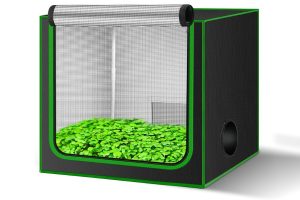Last Updated on June 20, 2024 by teamobn

There are a lot of gardening tools nowadays and a new one is discovered quite often. These tools make gardening a whole lot easier and more fun. Fortunately, you can simply DIY some of them. If you have time in your hands, tools, and materials, you can get them done in no time.

Here’s another tool that you can use, a seed spacing template. Using a seed spacer can help you simplify the planting process. This is actually a great way to organize your garden, allowing you to optimize available space. This way, you can double or triple your harvest if you’re planting crops. Additionally, weeds are easier to identify and remove because the plants grow in an organized manner, forming uniform grids.
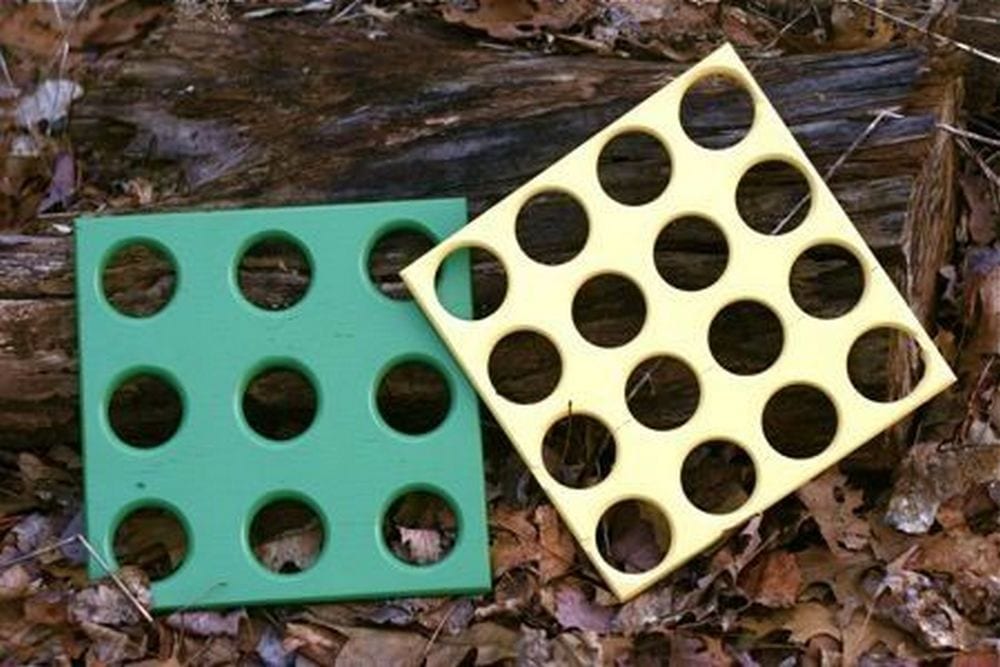
Making a seed spacer template won’t take more than a day. If you find yourself with nothing to do on a weekend, take on this project. You can even make several of these to give away as a nice present. Your garden-loving friends will appreciate it.
Crafting a Seed Spacing Template
Contents
Materials
- 12”x12” piece of wood
- Wood scraps
- Wood glue
- Screws
- Hinges
- Paint (different colors)
- Spray lacquer
Tools
- Colored markers
- Tape measure
- Pencil
- Sander
- Electric drill
- Drill bits
- Washers of different sizes
- Circular saw
Instructions
1. Prepare the Wood Base
- Measure and Cut: Start by measuring your 12”x12” piece of wood to ensure it’s precisely square. Use the tape measure and mark the dimensions with a pencil if needed.
- Sand the Surface: Use the sander to smooth the edges and surface of the wood. This will ensure that it’s safe to handle and gives a clean look.
2. Design the Template Grid
- Mark the Grid: With the tape measure, divide the wood into a grid. A common grid spacing might be 1-inch or 2-inch increments, but adjust based on your planting needs. Use the pencil to mark these intervals along the edges of the wood piece.
- Draw the Grid Lines: Connect the marks across the wood to form a grid pattern. This will guide where you’ll drill the holes for spacing.
3. Drill Holes for Planting Spots
- Select Drill Bits: Choose drill bits that match the size of the washers you’ll be using. Washers will help mark the planting spots.
- Drill the Holes: Carefully drill holes at each grid intersection. Ensure you drill straight through the wood to maintain uniformity. Keep the holes spaced evenly according to your grid lines.
4. Create and Attach Handles
- Cut Wood Scraps: Cut two pieces of wood scraps to a comfortable length (about 4-6 inches) to serve as handles.
- Attach Hinges: Use the hinges to attach the handles to opposite sides of the wood piece. This allows the handles to fold flat against the template when not in use, making it easier to store.
5. Customize with Colors and Labels
- Paint the Template: Apply different colors of paint to the template. This can help differentiate areas for different types of seeds or simply add a personal touch.
- Mark the Holes: Use colored markers to label the holes with seed names or spacing measurements if desired. This adds clarity and makes the template more user-friendly.
6. Seal the Wood
- Apply Spray Lacquer: Once the paint is dry, apply a coat of spray lacquer to protect the wood from moisture and wear. This will ensure the durability of your template.
7. Final Touches and Testing
- Smooth the Surface: Give the entire piece a final sanding to smooth out any rough edges or surfaces. This will also help the lacquer to adhere better.
- Test Your Template: Take your template to the garden and test it. Place it on the soil and use it to mark the planting spots. Ensure the handles are easy to use and the holes are properly aligned.
Click on any image to start the lightbox display. Use your Esc key to close the lightbox.
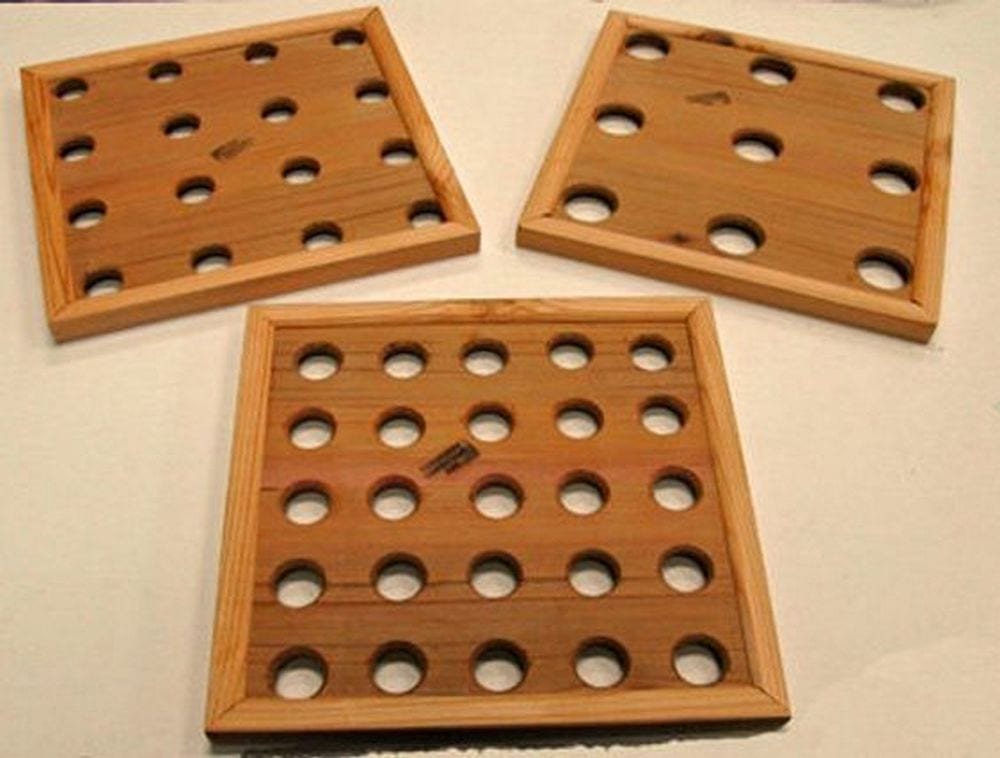

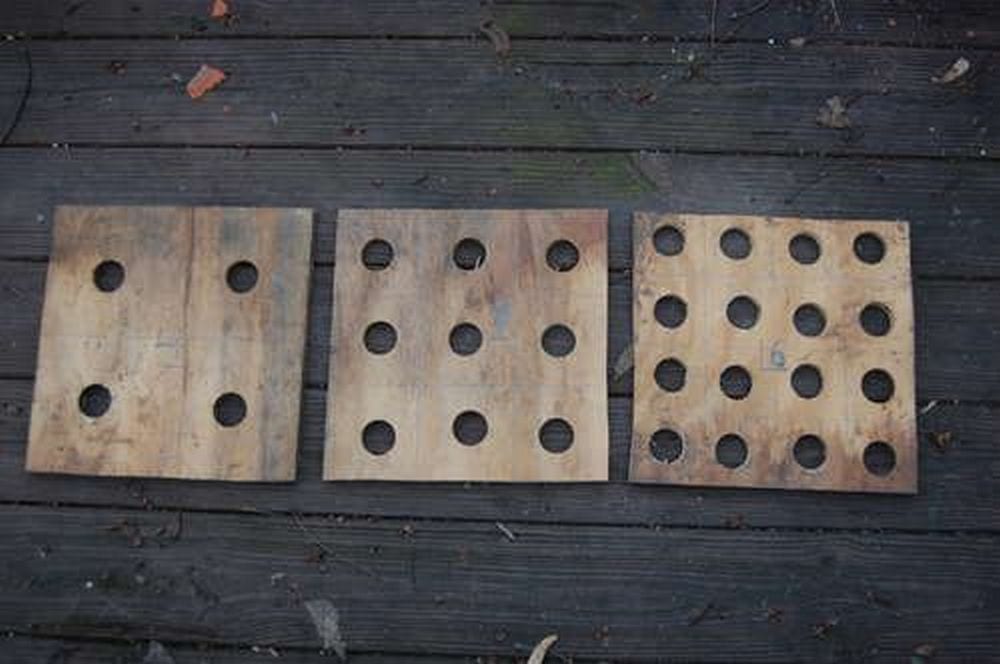

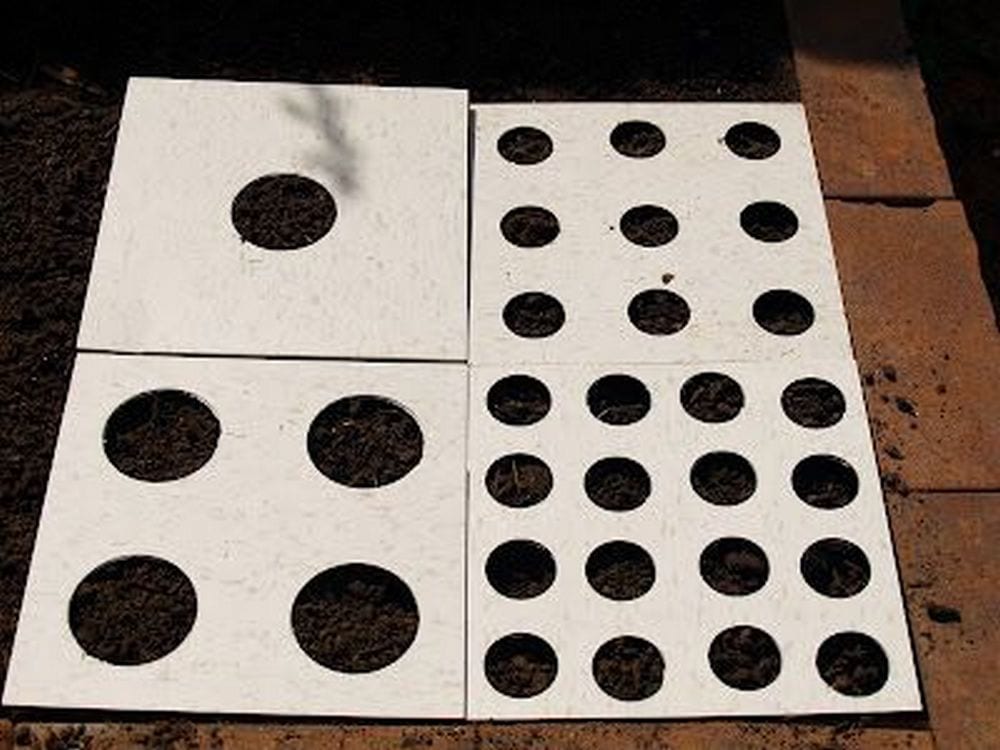


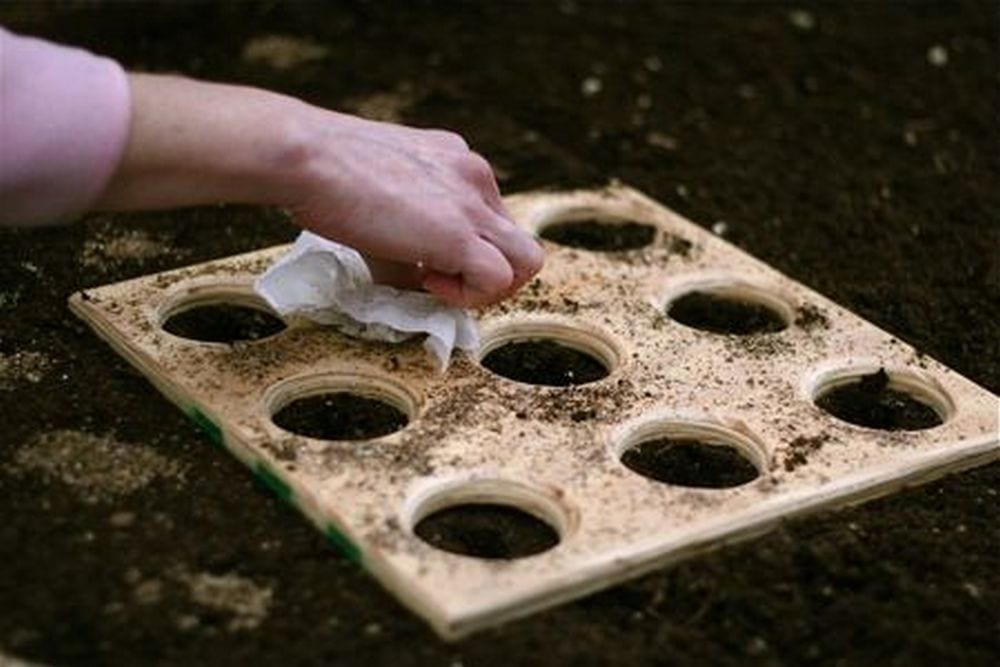
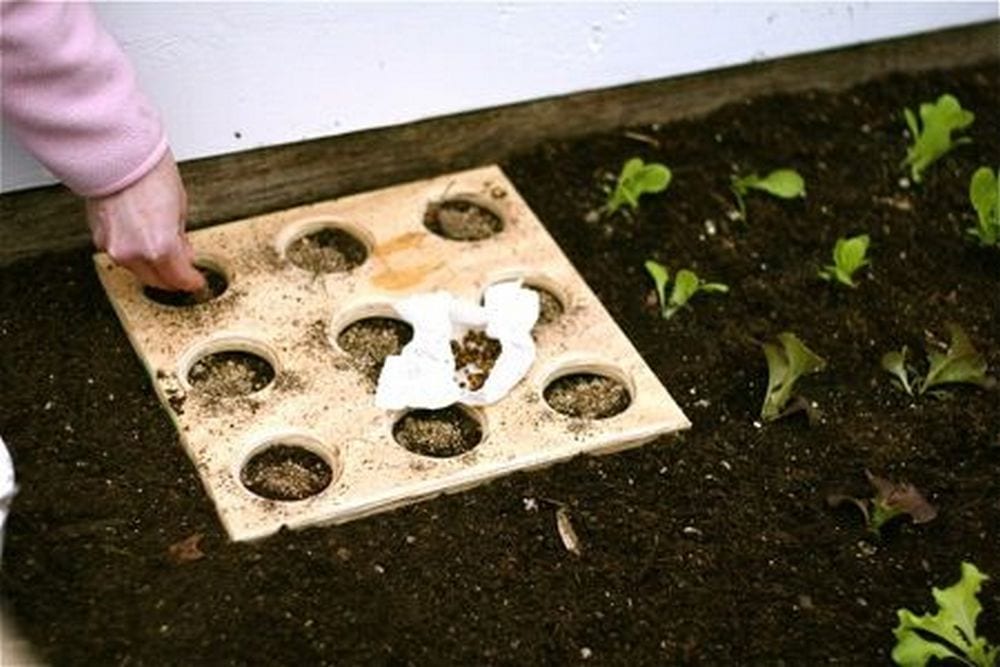
Ready to make a DIY seed spacing template? Watch this video to learn how.
Understanding Seed Spacing: Why It Matters
Proper seed spacing is a fundamental aspect of successful gardening. Whether you’re a novice or an experienced gardener, understanding the importance of seed spacing can significantly impact your garden’s health and productivity. Using a seed spacing template simplifies this process, ensuring that each plant has the optimal space to grow. Here’s why seed spacing is crucial and how a seed spacing template can help you achieve the best results.
Adequate Nutrient Access
Plants need access to soil nutrients to thrive. When seeds are planted too closely together, they compete for the same resources. This competition can lead to stunted growth and weaker plants. By using a seed spacing template, you can ensure that each plant has enough room to access the necessary nutrients, promoting healthier and more robust growth.
Proper Sunlight Exposure
Sunlight is another critical factor for plant health. Overcrowded plants can shade each other, leading to inadequate light for those in denser areas. A seed spacing template helps arrange plants in a way that maximizes their exposure to sunlight. This arrangement is essential for photosynthesis and the overall vitality of your garden.
Increased Harvest
Spacing your seeds correctly can lead to increased yields. When plants have the space to grow without interference, they can produce more fruit or vegetables. A seed spacing template allows for precise planting, optimizing your garden layout to maximize the number of plants and, consequently, your harvest.
Efficient Use of Space
Gardens, especially smaller ones, benefit greatly from efficient space use. A seed spacing template helps you plant more effectively, utilizing every inch of your garden bed. This efficiency can double or even triple your production compared to randomly planting seeds without a plan.
Organized Planting Rows
Weeds are a constant challenge in gardening. Organized planting rows created with a seed spacing template make it easier to identify and remove weeds. When plants are spaced uniformly, any weeds that appear are more noticeable and simpler to target.
Reduced Weed Competition
Proper seed spacing reduces the likelihood of weeds competing with your plants for nutrients and sunlight. A seed spacing template helps maintain clean lines and clear boundaries in your garden, minimizing the areas where weeds can take root and grow.
Improved Air Circulation
Good air circulation is vital to prevent fungal diseases and other issues that thrive in moist, crowded environments. A seed spacing template helps ensure that plants are not too close together, allowing air to flow freely between them. This airflow reduces the risk of disease and promotes healthier plant development.
Less Physical Stress
Plants grown too close together can physically stress each other as they vie for space. This stress can weaken their structures and make them more susceptible to pests and diseases. Using a seed spacing template avoids these issues by providing each plant with its own designated growing area, reducing stress and supporting stronger, more resilient plants.
Consistency and Precision
One of the main benefits of using a seed spacing template is the consistency it brings to your planting process. It allows for precise, uniform planting every time, removing guesswork and ensuring that each plant has the ideal conditions to thrive.
Time and Effort Savings
Planning and spacing seeds manually can be time-consuming and prone to errors. A seed spacing template simplifies this task, saving you time and effort while enhancing the accuracy of your planting. This tool makes the process more efficient and enjoyable, especially for larger garden projects.
Understanding and implementing proper seed spacing is key to a successful and bountiful garden. A seed spacing template is an invaluable tool that ensures each plant has the space and resources it needs to grow and thrive. By using a seed spacing template, you can optimize your garden layout, maximize yields, and maintain healthier plants, making your gardening experience both productive and enjoyable.
Types of Seed Spacing Templates
Creating a thriving garden starts with careful planning, and using a seed spacing template can make this task easier and more precise. Seed spacing templates come in various designs to suit different planting needs and garden layouts.
Here’s a look at the most common types of seed spacing templates and how they can help you achieve an organized and productive garden.
Grid Templates
Grid templates are among the most popular and versatile types of seed spacing templates. They feature a grid pattern that helps gardeners plant seeds in straight, evenly spaced rows. This type of template is ideal for crops that require consistent spacing, such as lettuce, carrots, or onions. The grid ensures each seed has adequate room to grow without overcrowding, making it easier to manage your garden and maintain plant health.
Grid templates can be easily customized to fit various plant spacing requirements. By adjusting the grid size, you can create different templates for a range of crops, from closely planted herbs to larger vegetables. This flexibility allows you to use the same basic template design for multiple planting needs, simply by changing the grid spacing.
Circular Templates
Circular seed spacing templates are designed for planting larger plants that require more space, such as tomatoes, peppers, or cabbages. These templates typically feature concentric circles that help you plant seeds in a radial pattern, ensuring each plant has ample room to spread out. Circular templates are especially useful for creating visually appealing garden layouts and maximizing space efficiency.
The radial design of circular templates allows for better airflow between plants, which is crucial for preventing diseases and promoting healthy growth. This spacing method ensures that even larger plants do not compete for space and sunlight, reducing the risk of overcrowding and physical stress on the plants.
Staggered Templates
Staggered templates offer a unique approach to seed spacing by arranging seeds in an offset pattern. This type of template is perfect for companion planting, where different types of plants are grown together to benefit each other. Staggered planting can enhance plant growth, improve pest resistance, and optimize space usage by allowing different plants to share resources efficiently.
By offsetting the seeds, staggered templates maximize the available planting area. This arrangement is particularly beneficial for gardens with limited space or when planting crops with varying growth habits. Using a staggered seed spacing template can help create a more diverse and productive garden.
Adjustable Templates
Adjustable seed spacing templates are designed to be flexible, allowing you to change the spacing as needed. These templates often feature movable parts or interchangeable pieces that let you customize the distance between planting holes. This versatility makes them ideal for gardeners who grow a wide variety of plants with different spacing requirements throughout the season.
Adjustable templates are convenient and reusable, making them a valuable tool for avid gardeners. They can adapt to different planting needs and seasons, reducing the need for multiple templates. This adaptability ensures that you always have the right tool for the job, regardless of what you’re planting.
Custom Templates
For those with specific gardening needs, custom seed spacing templates offer a tailored solution. You can create a template that matches the exact layout and spacing requirements of your garden. Whether you’re planting a unique combination of crops or have a garden with irregular shapes, custom templates provide the precision and flexibility you need to optimize your planting strategy.
Custom templates allow you to design a tool that suits your gardening style and preferences. You can include specific features, such as labeled planting holes or color-coded markers, to make the planting process easier and more enjoyable. This personalization can enhance your gardening experience and help you achieve better results.
Conclusion
Different types of seed spacing templates cater to various planting needs and garden designs. Whether you prefer the uniformity of grid templates, the flexibility of adjustable designs, or the tailored precision of custom templates, using a seed spacing template ensures your plants have the optimal space to grow. Choosing the right template for your garden can enhance plant health, maximize yields, and enjoy a more organized and efficient gardening process.






